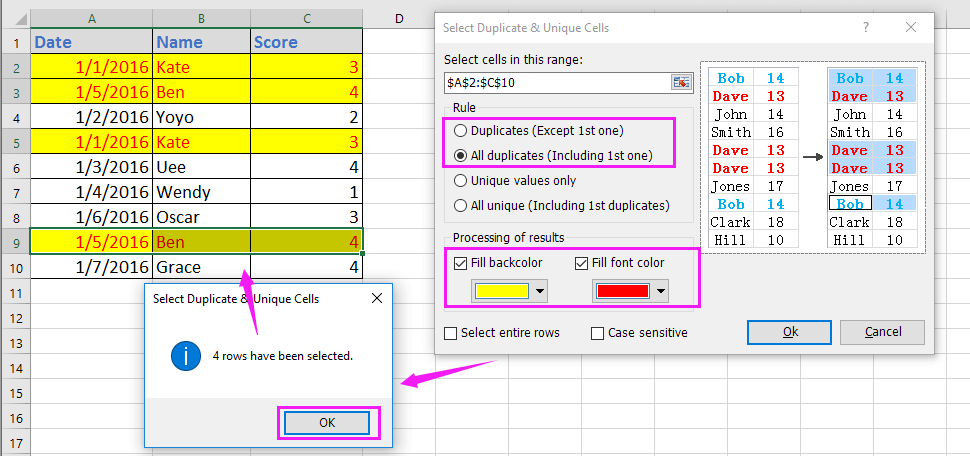5 Ways to Spot Duplicates in Excel 2007 Sheets

Excel 2007 might be an older version of Microsoft's renowned spreadsheet software, but its capabilities in data management, especially dealing with duplicates, are still very much relevant today. Whether you're cleaning data, analyzing datasets, or simply organizing your records, spotting duplicates efficiently can save you considerable time and effort. Here are five proven methods to identify and manage duplicates in Excel 2007:
1. Conditional Formatting

Excel’s conditional formatting tool is incredibly useful for visually distinguishing duplicates:
- Select the range where you want to find duplicates.
- Go to Home > Conditional Formatting > Highlight Cells Rules > Duplicate Values.
- Choose a format to highlight the duplicates. This will immediately show you which cells contain duplicate data.
💡 Note: This method is non-destructive; it won’t alter your data, just highlight it for better visibility.
2. Using the ‘Remove Duplicates’ Feature

For those who need to do more than just spot duplicates:
- Select the entire dataset or the specific columns you want to check.
- Go to Data > Remove Duplicates.
- In the dialog box, choose which columns you want Excel to consider for duplicates. You can keep duplicates based on all or selected columns.
- Click OK to remove the duplicates.
However, be cautious as this method will delete duplicate entries, which might not always be the desired action.
3. Advanced Filter

Advanced filters offer a powerful way to sift through data:
- Select the dataset.
- Navigate to Data > Advanced in the ‘Sort & Filter’ group.
- Choose Filter the list, in-place or Copy to another location if you want to keep the original dataset intact.
- Under Criteria range, leave it blank for all duplicates or set specific criteria.
- Check Unique records only to filter out duplicates.
4. Formula Based Approach

If you prefer to do things manually with more control:
- Use the COUNTIF function. For example, in a column with possible duplicates, type =COUNTIF(A:A, A2) into cell B2, assuming column A contains your data.
- This formula counts how many times the value in A2 appears in the entire column A.
- If the result is greater than 1, then you have duplicates.
Here’s an example:
| Item | Duplicate Check |
|---|---|
| Apple | =COUNTIF(A:A, A2) |
| Banana | =COUNTIF(A:A, A3) |
| Apple | =COUNTIF(A:A, A4) |

After this setup, your table should look like:
| Item | Duplicate Check |
|---|---|
| Apple | 2 |
| Banana | 1 |
| Apple | 2 |
5. Pivot Table

Pivot Tables are fantastic for data analysis:
- Select your data range.
- Go to Insert > Pivot Table.
- In the Pivot Table Field List, drag the column with potential duplicates to both the Row Labels and the Values area. Set the Value Field to show the Count of this item.
- Any value greater than 1 in the count column indicates duplicates.
In conclusion, Excel 2007 provides multiple avenues for managing duplicates, from quick visual identification with conditional formatting to more robust methods like filtering and formula-based checks. These techniques not only help in cleaning data but also in understanding its structure and ensuring data integrity. By employing these methods, you can streamline your data management process, ensuring your Excel sheets remain accurate and efficient. Remember to choose the method that best fits your data type and the specific task at hand.
What if I accidentally remove duplicates when I didn’t mean to?

+
Excel 2007 doesn’t have an “undo” feature for removed duplicates, so always make a copy of your data before performing irreversible actions like ‘Remove Duplicates’. You could use the ‘Advanced Filter’ method to copy unique records instead of altering the original data.
Can I highlight only the second occurrence of duplicates?

+
Yes, but it involves more complex steps with conditional formatting. You would set up conditional formatting rules based on a formula that checks if the COUNTIF result is greater than 1, but only applies formatting if it’s not the first occurrence.
Is there a way to delete duplicates while keeping the first occurrence in Excel 2007?

+
Yes, using the ‘Remove Duplicates’ feature under the Data tab will by default keep the first occurrence of any duplicate set, removing all subsequent ones.
How do I check for partial duplicates like matching names but different other details?

+
Use the ‘Advanced Filter’ option and define your criteria. Alternatively, use formulas like VLOOKUP or INDEX/MATCH to create a separate list of names and check for duplicates within that list.
What if my data has variations in case sensitivity that I want to consider as duplicates?

+
Excel 2007 by default is not case-sensitive when checking for duplicates. If you need case-sensitive checks, you’ll have to use functions like EXACT or write custom VBA code to compare text strings.